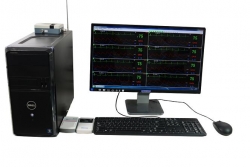Wechat QR code

TEL:400-654-1200

TEL:400-654-1200
Advances in contrast-enhanced ultrasonography in the diagnosis of breast cancer
With the changes in people's living environment, eating habits and living standards, the incidence of breast cancer increased year by year, and now ranks the first in the incidence of female malignant tumors. Conventional ultrasound and color doppler ultrasound have been widely used in breast cancer screening with the advantages of real-time, non-invasive and high repeatability, but the ability of color doppler ultrasound to show the low flow rate and low flow of blood flow in the microscopic blood vessels inside the lesions is limited. CEUS can detect microvessels <100 microns in diameter by using the characteristic that contrast agent cannot penetrate the cell gap of blood vessel wall and cannot diffuse into the tissue gap, so as to show the local microcirculation perfusion of tumor tissue in real time, providing more valuable information for the early diagnosis, metastasis evaluation and efficacy evaluation of breast cancer. This paper reviews the research progress of CEUS in the diagnosis of breast cancer, the display of metastatic lymph nodes, and the evaluation of efficacy.Meilun
1. Malignant breast tumor
1.1 microvessel density (MVD)
MVD is a gold standard for evaluating tumor angiogenesis and an important indicator for monitoring the occurrence and development of malignant tumors and predicting tumor recurrence and metastasis. Tumor blood supply can be divided into the early stage of the blood vessel and blood vessels, when tumor size < 1 cm3, lesions can get nutrition by osmosis, when tumor volume > 1 cm3, lesions can produce a large number of growth factors, promote new blood vessels to form, to obtain nutrition, so for > 1 cm3 volume of breast cancer by CEUS MVD and microvascular distribution of in order to improve the early diagnostic rate.
Roja et al. found that MVD in malignant lesions was higher than that in benign lesions, and MVD in peripheral tumor areas was higher than that in central tumor areas. Shen qiang et al put forward that the incidence of pulse index, non-uniform enhancement and blood perfusion defect in high MVD patients with breast cancer was higher than that in low MVD patients, which was attributed to the effect of MVD on the perfusion of breast cancer lesions, which was consistent with the research results of Wan et al. Therefore, malignant lesions should be considered for lesions with high MVD, edge region higher than middle region, uneven enhancement and central defect.Meilun

1.2CEUS breast lesions
CEUS has diverse manifestations, and most breast cancer manifestations are: (1) non-uniform high enhancement; (2) radial enhancement around the tumor; (3) the diameter line length of the enhanced mass was larger than that of two-dimensional ultrasound. (4) see filling defect. However, the benign lesions usually showed uniform enhancement and no increase in volume after enhancement. Xiao xiaoyun et al. discussed the time-intensity curve of breast lesions and concluded that the peaking time of malignant lesions was less than that of benign lesions. Wenhua et al. found that the peak intensity of benign lesions was lower than that of malignant lesions, but they did not clearly explain the quantitative methods and criteria for determining the peak intensity.
According to wang xiaohong et al., whether the distribution of contrast agent is uniform or not is of greater significance in the diagnosis of breast cancer. The study of an shaoyu et al. suggested that the enlargement of diameter line after breast cancer focus enhancement was an important feature of CEUS, and the reason was that tumor angiogenesis was abundant and infiltrated into the surrounding area, so the tumor contour was enlarged after angiography beyond the range seen by two-dimensional ultrasound. Saracco et al. studied the correlation between the clearance rate of benign and malignant breast lesions and the time after the injection of contrast agents, and found that the peak time of malignant tumors was 5s faster than that of benign tumors, and the clearance rate of malignant tumors was higher than that of benign tumors in the 50s, and the outflow curves of the two were the most different at 21s. It can be seen that there are some differences in the performance of benign and malignant lesions of breast CEUS, but the specific quantitative indicators are still to be further discussed.
Special pathological types of breast cancer are breast cancer other than invasive ductal carcinoma, intraductal carcinoma in situ and other common pathological types, including medullary carcinoma, invasive lobular carcinoma, mucinous carcinoma, etc. Due to the relatively rare occurrence of this type of breast cancer, there are relatively few CEUS studies related to it. Wang et al. proposed that CEUS is not superior to b-mode ultrasound in the diagnosis of breast cancer, but it has the value of assisting the diagnosis of some special types of tumors. In this study, they proposed: 1. 2. After enhancement, invasive lobular carcinoma showed unclear boundary, uneven enhancement, enlarged diameter, mostly accompanied by annular or perforating vessels. (3) the enhancement of mucinous carcinoma showed clear boundary, uneven enhancement, less than the boundary shown by two-dimensional ultrasound, and no annular or perforating vessels. Xu ping et al. also proposed that CEUS could improve the diagnosis rate of some special pathological types of breast cancer, and the average peak intensity of myeloid carcinoma after angiography was the highest among various pathological types of breast cancer. In summary, compared with two-dimensional ultrasound, CEUS can improve the diagnosis rate of medullary carcinoma, but no significant advantage has been found in the diagnosis of other special pathological types of breast cancer.
2. Lymph node metastasis of breast cancer
Sentinel lymph nodes are the first group of lymph nodes to receive the entire breast lymphatic drainage and to undergo metastasis. The correct evaluation of lymph node metastasis before operation is helpful for the planning of operation. Fan yunqing et al. found that CEUS had the same effect as meilan in terms of detection rate, accuracy and sensitivity of metastatic lymph nodes, but whether all capillary lymphatic vessels were developed or not was related to the operator's pressure intensity on the probe. The methods of injecting contrast agent into axillary lymph node CEUS include intravenous injection, subcutaneous injection in and around breast mass, and subcutaneous injection near areola, etc. Serve et al. believe that subcutaneous injection of ultrasound contrast agent around the mass can penetrate into lymphatic vessels through the wall of capillary lymphatic vessels, and then into lymph nodes, presenting as striated enhanced echo from the injection site to lymph nodes, so as to achieve better imaging effect of sentinel lymph nodes. Zhang Maochun applications such as areola lateral subcutaneous injection of contrast agent, the method of benign lymph nodes are characterized by homogeneous enhancement, metastasis lymph nodes show the centrality or no of uneven enhancement, and angiography after edge radial lines expand and lesions enhanced performance, considering the reason for cortical lymphatic sinus in lymph nodes and small lymphatic vessels within the tumor cell proliferation, gradually oppression lymphatic obstruction caused by lymphatic channel; When lymphatic vessels are completely compressed, contrast agents cannot pass through, and metastatic lymph nodes may present with no enhancement.
Liu is equal to the mass around 5 mm in 3, 6, 9 and 12 o 'clock direction subcutaneous injection of contrast agent, respectively, in the two-dimensional ultrasound is difficult to identify the inflammatory lymph nodes with metastatic lymph nodes were identified research, found that the metastatic lymph nodes enhanced mode from peripheral to internal annular enhancement, give priority to with peripheral or overall inhomogeneous enhancement, and inflammatory lymph node increases the time far earlier than metastatic lymph nodes, the specific enhancement pattern associated with inflammation in period.
3. Efficacy monitoring after neoadjuvant chemotherapy for breast cancer
Neoadjuvant chemotherapy for breast cancer has been widely used in clinic as a new method to control the progress of breast cancer and prolong the survival of patients. However, for the lesions resistant to chemotherapy drugs, preoperative chemotherapy can not only fail to benefit patients, but also cause the delay of operation time. Therefore, it is of great significance to monitor the early efficacy of neoadjuvant chemotherapy. At present, methods such as palpation, MRI and two-dimensional ultrasound are used to monitor the efficacy of neoadjuvant chemotherapy for breast cancer. Although lesion volume reduction is one of the effective indicators of neoadjuvant chemotherapy for breast cancer, its sensitivity is low. Although MRI effect is good but the price is high, is not suitable for popularization. According to the study of zhou liuhai et al., using CEUS to monitor the efficacy of breast cancer, the enhancement mode of the lesions after neoadjuvant chemotherapy was significantly changed, which was manifested as decreased intensity of enhancement and decreased perfusion area, suggesting that the degree of microvascular perfusion in tumor lesions was reduced after treatment. Other studies found that some lesions showed no enhancement after contrast, suggesting complete remission after neoadjuvant chemotherapy. Zhang Menglu time intensity curve of angiography after lesions such as study, found that after chemotherapy lesions of peak time, peak strength reduction, the area under the curve is reduced, tip into the tumor lesion of microvascular micro bubble slows down, reduced flow, reduce total, around the tumour and the decrease in the number of capillaries, is consistent with results such as zhang Lin. CEUS can accurately evaluate the efficacy of neoadjuvant chemotherapy, and has the advantages of safety and intuition. It has a high application value in evaluating the efficacy of neoadjuvant chemotherapy.